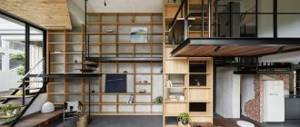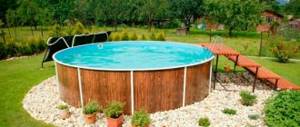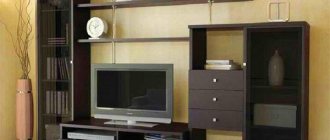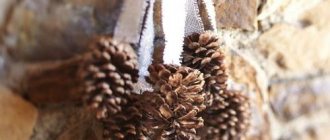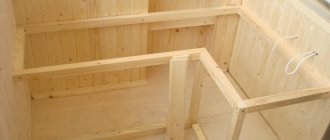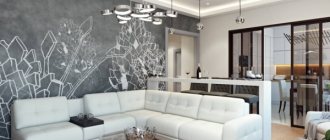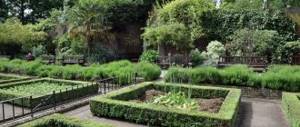Blue Tillandsia (Tillandsia cyanea)
A tropical guest from the Bromeliad family.
The original pink spike-shaped inflorescence does not need additional frills, but in the fall delicate lilac-violet flowers appear on it. Bright exotic tillandsia, photo from the site villaved.ru It grows very slowly. Comfortable temperature: in winter +18°C, all other times up to +25°C. Light partial shade, moderate watering, occasional spraying. High air humidity must be maintained constantly; this is one of the main conditions for growing.
Tillandsia flower close-up, photo from dachadecor.ru
When planting, good drainage is required; the soil mixture must include high-moor peat with crushed bark and leaf soil with charcoal. If you use a different planting mixture, it may grow poorly or not grow at all.
Read even more interesting information about this unusual plant in the material Tillandsia osniformes: an exotic, an epiphyte and simply a stylish interior object.
Ads by
Euphorbia tirucalli
This is a tree-like plant of the Euphorbiaceae family.
An evergreen succulent with intricately curved bare branches and small greenish-yellow flowers. Its juice (like all euphorbias) is poisonous and can cause a slight burn or an allergic reaction. Euphorbia tirucalli, or rubber plant, photo from gartenjournal.net A soil mixture for cacti and succulents is suitable for it. The pot should not be large, otherwise the spurge will not grow well (by the way, it can reach 1 m in height and grows well in breadth). Water moderately, no need to spray. Choose a bright place, but light partial shade is also suitable. In the sun the stems will be slightly yellowish, in the shade they will be a richer green color.
Close-up of Euphorbia tirucalli flowers, photo from wikimedia.org
Needs a winter dormancy period (usually after flowering) at a temperature of +12…+15°C. In summer you can take it outside to light partial shade.
What types of indoor plants are best for a home or apartment?
The choice of indoor plants for modern interiors is great. It is worth paying attention to several types that are suitable for placement in prominent places. Some of them have been known for a long time, but they have only become fashionable in recent years.
- Guinea reel (sansewieria) has been an underappreciated plant for many decades. Currently, due to its ease of cultivation and attractive appearance, it is used everywhere, including for decorating modern interiors. It should be grown in long rectangular pots. The plant usually grows to 50-60cm tall and has stiff, upright, sword-shaped leaves.
- Zamioculcas deciduous is a species that has gained immense popularity in recent years. The plant should be grown individually in a central location in the room. In good conditions it grows up to 100 cm in height. The plant is practically indestructible - it quickly recovers even after drying out. Large pots required.
- Philodendron bipinnatus is a houseplant prized for its huge feathery leaves. A perennial piece can be the biggest statement piece in a modern living room. Unfortunately, it takes up a lot of space.
- Guatemalan Yucca - Despite the passing of the years, it is still very popular as a houseplant. In a composition with a long narrow container (for example, metallic color) it can be an excellent decoration for modernist interiors.
- Monstera is a vigorous plant that requires a lot of space. It is decorated with large shiny leaves.
Hypocyrta glabra
Epiphytic ampelous plant, representative of the Gesneriaceae family.
With beautiful small juicy green glossy leaves. Hypocyrta grows well indoors, photo from wordpress.com It blooms from spring to late autumn with bright orange flowers of unusual shape, which can be seen in the photo below. Dry air and temperature changes during cultivation are unacceptable. As temperatures drop, plant growth slows down. Hypocyrta flowers close-up, photo from mtdata.ru
Air and soil humidity should be normal; in winter, watering should be reduced. Loves a bright place (preferably direct sunlight during the day). The room temperature should be moderate, lower in winter: +12…+15°C.
Maidenhair
Very often, among indoor non-blooming flowers, you can find ferns, for example with a name such as adiantum, the photo of which is posted below. This is a herbaceous evergreen crop with incredible durability.
Its foliage is interestingly curled and colored pinkish-cream. To keep it at home, the flower needs to be provided with a semi-dark room, and also be moved to a cool place during the winter months.
May be interesting How to water potatoes correctly: features, norms and rules of watering Bacteriosis of cucumbers or angular leaf spot: methods of treatment and prevention Planting cucumbers in plastic containers
Lachenalia aloides
It will give its owner elegant flowering in the middle of winter: clusters of elongated yellow tube-shaped flowers with a greenish, reddish, pink or purple tint appear on tall multi-colored stems.
Lachenalia aloeideae, photo from staticflickr.com 2-3 weeks after flowering, watering should be reduced and then stopped altogether. In September, the plant needs to be transplanted into fresh soil (the top of the bulb is located below the soil level) and watered once; When shoots appear, you can continue watering.
Lachenalia flowers close-up, photo from florainhouse.ru
Lachenalia loves moisture, so sometimes it needs to be sprayed. Prefers sun, especially on window sills, where there is direct sunlight half the day, but does not accept heating. It develops and blooms well at temperatures of +7…+15°C. An enclosed balcony with low temperatures above zero in winter will be just right for her. It reaches a height of 35-45 cm.
Calathea
It is valued for its decorative leaves: they can be from white to deep green, with unusual stains and patterns. And the saffron calathea (Calathea crocata) is also for the beauty of its flowers. The plant loves care and constant care: it needs to be protected from drafts, direct sunlight (light partial shade or diffused light), placed in a warm room in winter and provided with high air humidity. Watering is constant, reduce the frequency in winter. It should be replanted once every 2 years.
The most popular forms of calathea:
- Calathea makoyana - wide leaves patterned on the front side, purple on the back;
Calathea Makoya, photo from static.baza.farpost.ru
- decorated calathea ( Calathea ornata) - pink stripes on the leaves on top, purple stripes on the inside;
Calathea decorated, photo from static.flickr.com
- Calathea lubbersii - light green oval leaves with bright green and yellow spots;
Calathea Lubbersa, photo from mandarin-shop.ru
- wonderful calathea (Calathea insignis) - with large (about 45 cm long) lanceolate leaves with oval patterns;
Calathea is wonderful, photo from news.hitsad.ru
- striped calathea (Calathea zebrina) - on leaves about 30 cm long there are spectacular dark stains;
Calathea striped during flowering, photo from herbcare.ru
- pinkish-colored calathea (Calathea roseopicta) - oval leaves with a central pink stripe.
Calathea pinkish-colored, photo from the site s018.radikal.ru
- saffron calathea (Calathea crocata) – one of its main advantages is its long flowering. Flowers on straight peduncles. The upper side of the leaves is dark green, the lower side is greenish-purple.
Calathea saffron, photo from the site mandarin-shop.ru To keep your indoor plants vigorous and blooming well, do not forget to feed them.
You can choose fertilizers for them in our market, which unites large online stores. Take a look at the selection of Fertilizers for indoors. Fertilizer Health for violets and begonias 109 rub.
Russian Vegetable Garden
Fertilizer Phosphatovit for indoor plants 129 RUR
Russian Vegetable Garden
Fertilizer for indoor flowers Prompter 49 RUR
Russian Vegetable Garden
Fertilizer for indoor flowers Miracle-Humus 59 RUR
Russian Vegetable Garden
Artificial plants in the interior
No maintenance is required for artificial plants; they always look beautiful. This is why artificial flowers are an ideal option for many. However, just recently, placing artificial plants in the interior of a living space was considered vulgar, indicating a complete lack of taste, because such artificial flowers were made using cheap materials and in simple forms. In addition, the artificial plants had unnatural bright colors, which made the situation worse.
- Artificial plants and flowers may not fit into every interior. For example, tall bouquets, weighty wreaths and woven flower garlands will go quite well with the classic style.
- If the room is decorated in a minimalist style, then artificial flowers should be chosen in oriental motifs. Jasmine, bamboo and rice straws are ideal for this purpose.
- Artificial flower arrangements will complement the look of a high-tech interior well. Ornamental plants will decorate the interior for a long time, and also fill it with a feeling of inspiration and beauty; they do not require care. In this style, it is best to use artificial compositions in muted, soft tones.
We invite you to familiarize yourself with the home plant Kalanchoe medicinal properties
Artificial plants have certain advantages, one of them is that they require no maintenance. Or rather, minimal care is required. It is enough to wipe the artificial compositions from dust. Care will also include placing artificial flowers away from direct sunlight, as they are prone to fading.
Kohleria
The bush is quite compact, with beautiful pubescent leaves and bright flowers.
She was once extremely popular! Nowadays you don’t see her often, and it’s completely in vain! This plant has become widespread as a hanging plant, so it is better to choose a pot for it or a pot on a stand, but with the expectation of a long time. After replanting, the soil from the leaves is extremely difficult to wash off, leaving dark stains. Koleria Shoots of Koleria are straight, not branching. In the indoor version, the plant is represented by hybrid forms. It can bloom for a long time, about 2 months; the flowers are delicate, fluffy, patterned. It belongs to the Gesneriaceae family and requires dormancy in winter, so the upper stems are cut off and the nodules are given time to gain strength and grow at a temperature not higher than +14°C, but not lower than +12°C. It likes diffused light and high humidity, but the air around the plant should be sprayed: if water gets on the leaves, spots will form on them, like a burn. For the same reason, you should avoid exposing the leaves to direct sunlight. Our reader shares her experience of growing Koleria: Koleria fluffy-flowered - a Colombian beauty for interior decoration.
Location Possibilities
If the living room is small, this does not mean that flowers cannot be placed in it.
Of course, a large space allows you to install several different compositions at once, while a small room can be decorated with one of these elements.
When placing plants here, you don’t need to rush with all your might. Simplicity is appropriate: choosing a pair of plants that are most useful or picturesque. If there is an acute lack of free space, it will be more relevant to place flowers in flowerpots. This will allow you to create, even in the smallest space, a small island that is simply green or capable of blooming.
The situation is different with a room with space and good lighting. There is no way to spoil it, even if you place a dozen flowers here. If you don’t want to work with vegetation on your own or have difficulty determining what is more suitable or how it should be positioned correctly, you can always turn to professionals who will help with the design.
If you do this without outside help, you just need to trust your taste, preferences, and take into account the lighting needs of the selected specimens. There is no need to be upset if the designed project does not correspond to the specific styles described by the designers. The main point is that the landscaping done is most comfortable for the owner and household members, brings them joy, and does not interfere with moving around the living room.
Lack of free space is not a reason to refuse living beauty
Frizea (Vriesea)
There are several varieties with large, bright racemose inflorescences.
Frizeya, photo from the site zakupator.com It is necessary to replant when the pot has become too small for the plant. After flowering has finished, you should definitely remove the mother rosettes to give the plant the opportunity to recover and form new ones.
It develops indoors at normal room temperature; in winter it needs to be lowered, but not less than +15°C. Choose a bright place with diffused sunlight. Make sure that the soil in the pot does not dry out, and there should always be water in the middle of the leaves of the rosette of leaves. The water needs to be renewed every few months.
Ficus
Another hardy and unpretentious flower that can be kept at home is the ficus. There are several varieties of the plant, each of which does not require special care. They can easily tolerate dry air, infrequent watering, and lack of lighting.
Along with this, this culture spends its resources on improving indoor air, taking in toxic elements such as phenol and benzene, and releasing beneficial substances that help get rid of depression and insomnia. For every home there is a suitable type of ficus that will fit organically into the interior.
